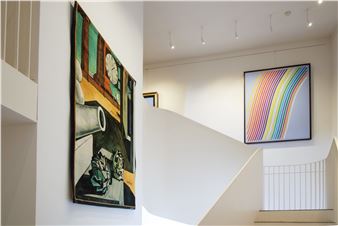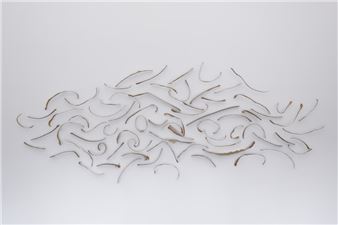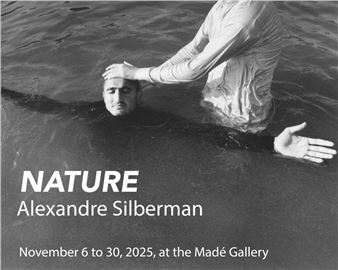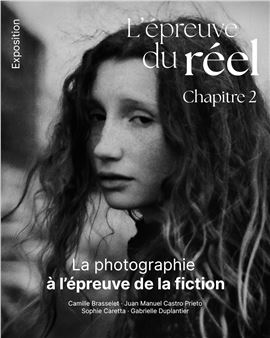Massimo Campigli: The Archaic Roots of the Contemporary
The uniqueness of Massimo Campigli's art - which has captivated audiences everywhere, earning him no fewer than fourteen appearances at the Venice Biennale - lies in his ability to combine the lessons of the past with imagery that never loses its relevance. In Campigli's work, ancient resonances are translated into utterly contemporary, sober, and essential images against a sunny and luminous pictorial background. His earthy palette, the pictorial density reminiscent of frescoes, his primitivism, and the essential forms inspired by ancient civilizations - particularly the Etruscan civilization - coexist with an image construction that yields thoroughly contemporary results. His approach has always been the search for an archetype, an ancestral form, rigor and symmetry, harmony and balance, but also an inner tranquility that emanates from his canvases.
The works on display retrace some of the artist's most cherished subjects, such as his architectural designs inspired by the creations of Gio Ponti, a close friend with whom Campigli collaborated on several occasions, notably for the headquarters of the University of Padua and the large painting created for the Ferrania building in Milan. A study for this project, titled La Spiaggia (1937, below left), can be admired in the exhibition. But architecture is always present, sometimes in a realistic way - as in the scene of the painting Theatre / La Scala / Teatro (1951, below right) - and sometimes in elementary forms of squares and circles as in the canvas Medaglioni (1962, immediately above), two works that evoke a collective and timeless dimension. Another favored theme is the female figure, an archetype never reduced to a simple naturalistic representation, but reminiscent of the images and postures of idols, caryatids and totems. In works such as Donna con anfora, (1930, above) or Idole au Corsage rouge (1962), solemn and hieratic figures, captured in ritualistic postures and punctuated by rhythmic lines and geometric structures, appear suspended in time and space, in an eternity that consecrates their metamorphosis from the human to the divine state. Also present in the exhibition is the theme of play with the canvas Pallavolo (1931).
The decision to host this exhibition in Paris pays tribute to the crucial role that the city played in Campigli's development from 1919 onwards, when the artist frequented the intellectual and artistic circles dominated by primitivism. Holding an exhibition in the city that had such a decisive influence on his career is therefore not only symbolic but also historical, an ideal return to the places that helped forge his most authentic voice. The exhibition is part of a long-standing effort by the gallery to explore the artist's work in greater depth, one of the most recent chapters of which was the exhibition "Massimo Campigli and the Etruscans. Una pagana felicità / A Pagan Happiness", organized thanks to the Fondazione Calarota - established by Franco and Roberta Calarota, founders of the Galleria d'Arte Maggiore g.a.m. - in its central space ACP - Palazzo Franchetti in Venice in 2021/2022, in collaboration with the Italian Ministry of Culture/Superintendence of Archaeology, Fine Arts, and Landscape for the province of Viterbo and southern Etruria.
The works carefully selected for the exhibition highlight, in all its originality, Campigli's ability to create a bridge between past and future, developing a vision that reinvents the ancient in a contemporary key, making his art unique in the European panorama.
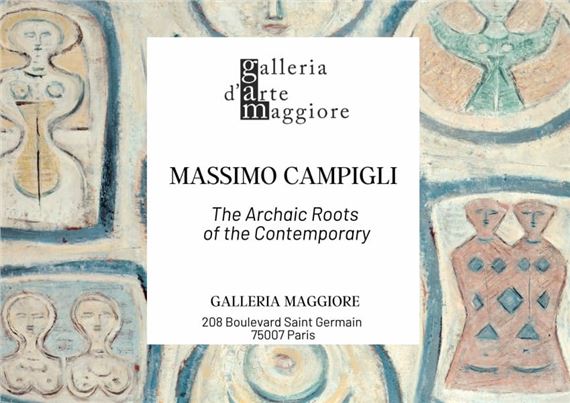
Recommended for you
The uniqueness of Massimo Campigli's art - which has captivated audiences everywhere, earning him no fewer than fourteen appearances at the Venice Biennale - lies in his ability to combine the lessons of the past with imagery that never loses its relevance. In Campigli's work, ancient resonances are translated into utterly contemporary, sober, and essential images against a sunny and luminous pictorial background. His earthy palette, the pictorial density reminiscent of frescoes, his primitivism, and the essential forms inspired by ancient civilizations - particularly the Etruscan civilization - coexist with an image construction that yields thoroughly contemporary results. His approach has always been the search for an archetype, an ancestral form, rigor and symmetry, harmony and balance, but also an inner tranquility that emanates from his canvases.
The works on display retrace some of the artist's most cherished subjects, such as his architectural designs inspired by the creations of Gio Ponti, a close friend with whom Campigli collaborated on several occasions, notably for the headquarters of the University of Padua and the large painting created for the Ferrania building in Milan. A study for this project, titled La Spiaggia (1937, below left), can be admired in the exhibition. But architecture is always present, sometimes in a realistic way - as in the scene of the painting Theatre / La Scala / Teatro (1951, below right) - and sometimes in elementary forms of squares and circles as in the canvas Medaglioni (1962, immediately above), two works that evoke a collective and timeless dimension. Another favored theme is the female figure, an archetype never reduced to a simple naturalistic representation, but reminiscent of the images and postures of idols, caryatids and totems. In works such as Donna con anfora, (1930, above) or Idole au Corsage rouge (1962), solemn and hieratic figures, captured in ritualistic postures and punctuated by rhythmic lines and geometric structures, appear suspended in time and space, in an eternity that consecrates their metamorphosis from the human to the divine state. Also present in the exhibition is the theme of play with the canvas Pallavolo (1931).
The decision to host this exhibition in Paris pays tribute to the crucial role that the city played in Campigli's development from 1919 onwards, when the artist frequented the intellectual and artistic circles dominated by primitivism. Holding an exhibition in the city that had such a decisive influence on his career is therefore not only symbolic but also historical, an ideal return to the places that helped forge his most authentic voice. The exhibition is part of a long-standing effort by the gallery to explore the artist's work in greater depth, one of the most recent chapters of which was the exhibition "Massimo Campigli and the Etruscans. Una pagana felicità / A Pagan Happiness", organized thanks to the Fondazione Calarota - established by Franco and Roberta Calarota, founders of the Galleria d'Arte Maggiore g.a.m. - in its central space ACP - Palazzo Franchetti in Venice in 2021/2022, in collaboration with the Italian Ministry of Culture/Superintendence of Archaeology, Fine Arts, and Landscape for the province of Viterbo and southern Etruria.
The works carefully selected for the exhibition highlight, in all its originality, Campigli's ability to create a bridge between past and future, developing a vision that reinvents the ancient in a contemporary key, making his art unique in the European panorama.

 ARTISTS
ARTISTS











